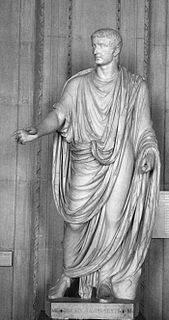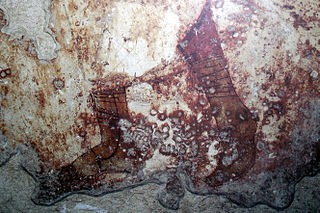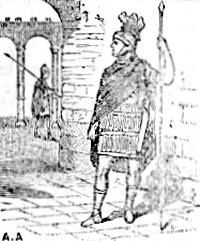 W
WClothing in ancient Rome generally comprised a short-sleeved or sleeveless, knee-length tunic for men and boys, and a longer, usually sleeved tunic for women and girls. On formal occasions, adult male citizens could wear a woolen toga, draped over their tunic, and married citizen women wore a woolen mantle, known as a palla, over a stola, a simple, long-sleeved, voluminous garment that hung to midstep. Clothing, footwear and accoutrements identified gender, status, rank and social class. This was especially apparent in the distinctive, privileged official dress of magistrates, priesthoods and the military.
 W
WAn abolla was a cloak-like garment worn by ancient Greeks and Romans. Nonius Marcellus quotes a passage of Varro to show that it was a garment worn by soldiers, and thus opposed to the toga.
 W
WIn ancient Rome, an angusticlavia, angusticlavus, or angustus clavus was a narrow-strip tunic (tunica) with two narrow vertical Tyrian purple stripes (clavi). The tunic was typically worn under the toga with the right side stripe visible.
 W
WThe calceus was a mid-weight, outdoor walking "shoe-boot", worn in ancient Rome. It was flat-soled, usually hobnailed and entirely covered the foot and ankle, up to the lower shin. It was secured with crossed thongs or laces.
 W
WA chiton is a form of tunic that fastens at the shoulder, worn by men and women of Ancient Greece and Rome. There are two forms of chiton. One is the Doric chiton and the later Ionic chiton. According to Herodotus, popular legend was that Athenian women began to wear the chiton as opposed to the peplos after several women stabbed a messenger to death with the bronze pins characteristic of that garment.
 W
WCoa vestis is an ancient type of fabric named after its point of origin, the Greek island Kos.
 W
WA fibula is a brooch or pin for fastening garments, typically at the right shoulder. The fibula developed in a variety of shapes, but all were based on the safety-pin principle. Unlike most modern brooches, fibulae were not only decorative; they originally served a practical function: to fasten clothing, such as cloaks. In English, "fibula" is not a word used for modern jewellery, but by archaeologists, who also use "brooch", especially for types other than the ancient "safety pin" types, and for types from the British Isles.
 W
WA fibula is a brooch or pin for fastening garments, typically at the right shoulder. The fibula developed in a variety of shapes, but all were based on the safety-pin principle. Unlike most modern brooches, fibulae were not only decorative; they originally served a practical function: to fasten clothing, such as cloaks. In English, "fibula" is not a word used for modern jewellery, but by archaeologists, who also use "brooch", especially for types other than the ancient "safety pin" types, and for types from the British Isles.
 W
WA laurel wreath is a round wreath made of connected branches and leaves of the bay laurel, an aromatic broadleaf evergreen, or later from spineless butcher's broom or cherry laurel. It is a symbol of triumph and is worn as a chaplet around the head, or as a garland around the neck.
 W
WThe paenula or casula was a cloak worn by the Romans, akin to the poncho. This was originally worn only by slaves, soldiers and people of low degree; in the 3rd century, however, it was adopted by fashionable people as a convenient riding or traveling cloak; and finally, by the sumptuary law of 382 it was prescribed as the proper everyday dress of senators, instead of the military chlamys; thereafter, the toga was reserved for state occasions.
 W
WThe palla was a traditional ancient Roman mantle worn by women, fastened by brooches. It was similar to the pallium that a man would wear. The shape was rectangular instead of semi-circular, as with the traditional toga. The garment dates to the 3rd century BC.
 W
WThe pallium was a Roman cloak. It was similar in form to the palla, which had been worn by respectable Roman women since the mid-Republican era. It was a rectangular length of cloth, as was the himation in ancient Greece. It was usually made from wool or flax, but for the higher classes it could be made of silk with the use of gold threads and embroideries.
 W
WIn Republican and Imperial Rome, the paludamentum was a cloak or cape fastened at one shoulder, worn by military commanders and rather less often by their troops. As supreme commander of the whole Roman army, Roman emperors were often portrayed wearing it in their statues and on their coinage. After the reign of Augustus, the paludamentum was restricted to the Emperor. Children would also wear it sometimes, when there was bad weather and they needed protection.
 W
WPerizoma is a type of loincloth that originated with the Minoan civilization in Crete. Surviving depictions show it being worn by male and female acrobats.
 W
WThe pileus was a brimless, felt cap worn in Ancient Greece, Etruria, Illyria, Pannonia and surrounding regions, later also introduced in Ancient Rome. In the 5th century BC, a bronze version began to appear in Ancient Greece and it became a popular infantry helmet. It occasionally had a horsehair crest. The Greek πιλίδιον and Latin pilleolus were smaller versions, similar to a skullcap. The plis worn today in Albania and Kosovo is thought to originate from a similar felt cap worn by the ancient Illyrians.
 W
WPteruges refers to strip-like defences for the upper parts of limbs attached to armor in the Greco-Roman world.
 W
WThe sagum was a garment of note generally worn by members of the Roman military during both the Republic and early Empire. Regarded symbolically as one of war by the same tradition which embraced the toga as a garment of peace, it was slightly more practical, consisting of a simple rectangular segment of cloth fastened by a leather or metal clasp and worn on top of the armor. The fabric was unwashed wool, saturated with lanolin ; it was traditionally dyed bright red.
 W
WA soccus, meaning slipper in Latin, is a loosely fitting shoe that has no ties, a sole without hobnails, and a separate leather upper. They were worn by the Ancient Romans, at first especially by comic actors. Later it became popular with the general public, with several types being described in the Edict of Diocletian.
 W
WThe stola was the traditional garment of Roman women, corresponding to the toga, that was worn by men. The stola was usually woollen.
 W
WA subligaculum was a kind of undergarment worn by ancient Romans. It could come either in the form of a pair of shorts, or in the form of a simple loincloth wrapped around the lower body. It could be worn both by men and women. In particular, it was part of the dress of gladiators, athletes, and of actors on the stage. Leather subligacula have been found in excavations of Roman London.
 W
WThe toga, a distinctive garment of ancient Rome, was a roughly semicircular cloth, between 12 and 20 feet in length, draped over the shoulders and around the body. It was usually woven from white wool, and was worn over a tunic. In Roman historical tradition, it is said to have been the favored dress of Romulus, Rome's founder; it was also thought to have originally been worn by both sexes, and by the citizen-military. As Roman women gradually adopted the stola, the toga was recognized as formal wear for male Roman citizens. Women engaged in prostitution might have provided the main exception to this rule.